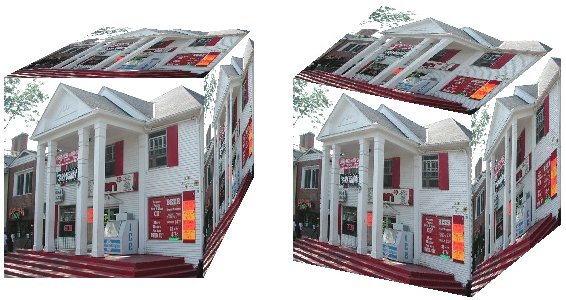- About MAA
- Membership
- MAA Publications
- Periodicals
- Blogs
- MAA Book Series
- MAA Press (an imprint of the AMS)
- MAA Notes
- MAA Reviews
- Mathematical Communication
- Information for Libraries
- Author Resources
- Advertise with MAA
- Meetings
- Competitions
- Programs
- Communities
- MAA Sections
- SIGMAA
- MAA Connect
- Students
- MAA Awards
- Awards Booklets
- Writing Awards
- Teaching Awards
- Service Awards
- Research Awards
- Lecture Awards
- Putnam Competition Individual and Team Winners
- D. E. Shaw Group AMC 8 Awards & Certificates
- Maryam Mirzakhani AMC 10 A Awards & Certificates
- Two Sigma AMC 10 B Awards & Certificates
- Jane Street AMC 12 A Awards & Certificates
- Akamai AMC 12 B Awards & Certificates
- High School Teachers
- News
You are here
Geometric Photo Manipulation - Projections
Analytic geometry of the sort usually found in multivariable calculus enters our discussion as we imagine displaying a three dimensional object on a two-dimensional computer screen or photographic print. Figure 2 depicts the two most common ways of accomplishing such a projection.

(a) Perspective projection (b) Orthographic projection
Figure 2
- In perspective projection [Figure 2(a)], we imagine that the eye of an observer is at a point
 that is neither a point of the object (the cube) nor a point of a given plane
that is neither a point of the object (the cube) nor a point of a given plane  , where the scene will be projected. Then any point
, where the scene will be projected. Then any point  of the object is projected to the point where the line through
of the object is projected to the point where the line through  and
and  meets the plane
meets the plane  . The final step is to coordinatize this plane so as to identify its points with the pixels of the output image.
. The final step is to coordinatize this plane so as to identify its points with the pixels of the output image.
- In orthographic projection [Figure 2(b)], we imagine that the eye of the observer is at infinity, and the observer views the scene along a fixed direction vector
 . This time, each point
. This time, each point  of the scene is projected to the point where the line through
of the scene is projected to the point where the line through  with direction vector
with direction vector  meets a given plane
meets a given plane  (a plane with normal vector
(a plane with normal vector  ).
).

(a) Perspective projection (b) Orthographic projection
Figure 3
As one can see from Figure 3, a cube drawn with a perspective projection has back edges that are smaller in size than the front edges, suggestive of the greater distance from the eye. In contrast, the orthographic projection yields front and back edges of the same size. Both projection methods are fundamental in computer graphics, and I think a discussion of them can provide a compelling application of certain topics from calculus and linear algebra.
Tom Farmer, "Geometric Photo Manipulation - Projections," Convergence (October 2005)




